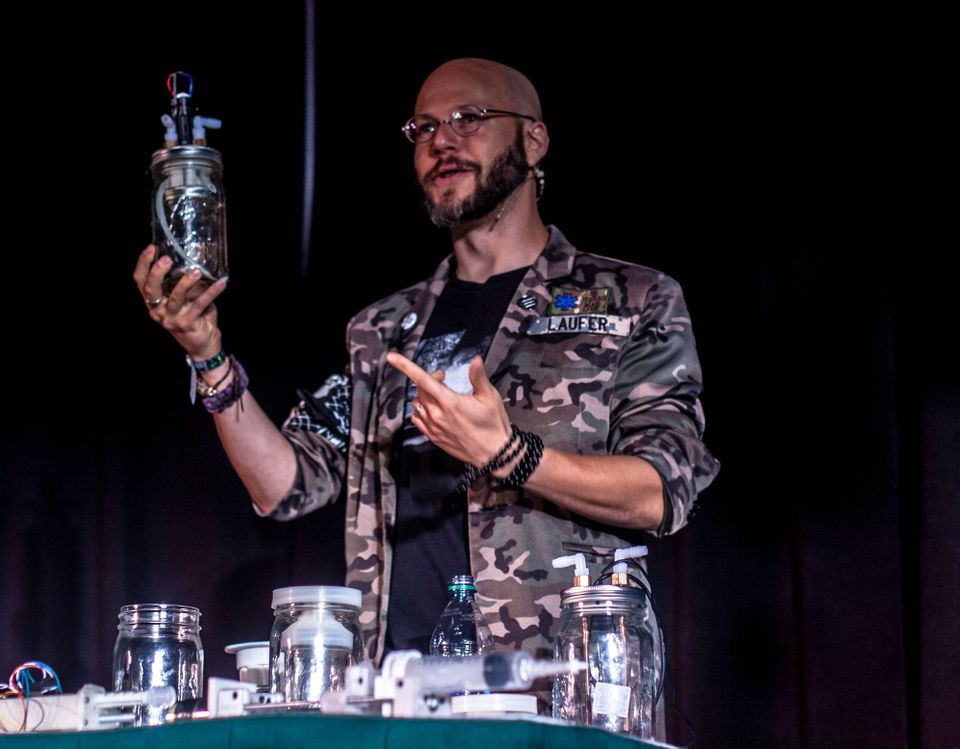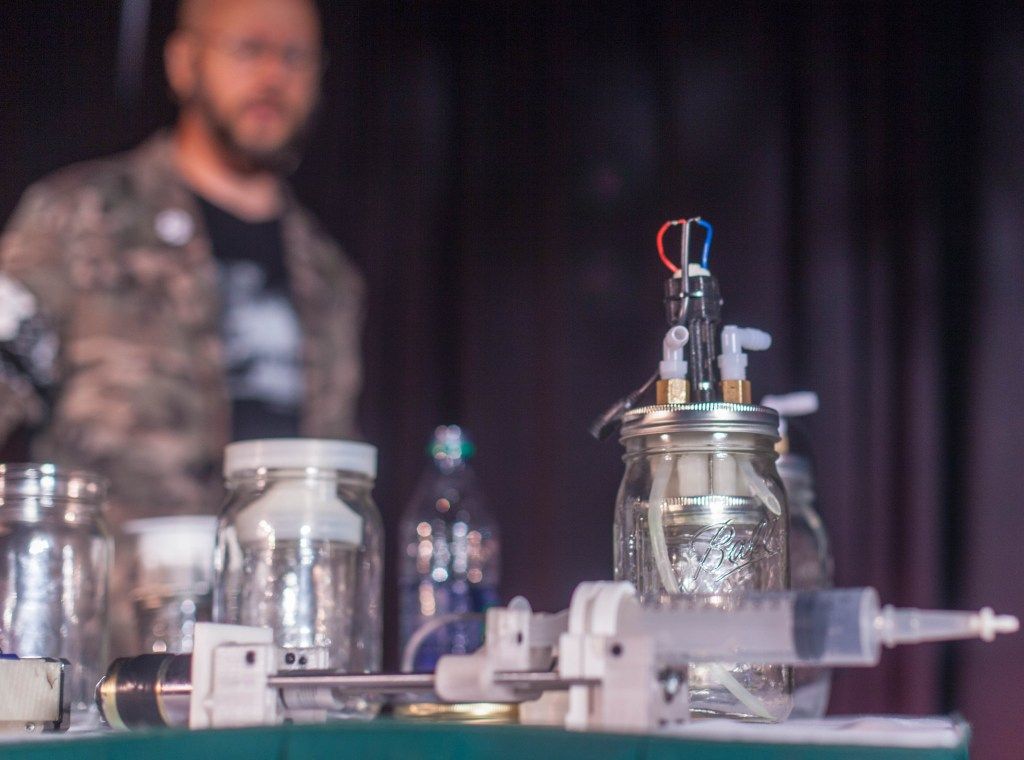Biohacker’s latest answer to health care hurdles: Homebrew meds

NEW YORK CITY—File sharing saves lives, Michael Laufer argues. Especially when the files contain instructions on how to turn the common but destructive narcotic painkiller oxycodone into its best-known overdose antidote, naloxone.
During his presentation here at this year’s Hackers On Planet Earth (HOPE) biennial hacker confab, Laufer and the Four Thieves Vinegar biohacking collective he represents debuted a 3D-printable version of the chemical reactor hardware for turning chemicals, as well as painkillers like oxycodone, into more helpful medication.
He demonstrated how biohackers could find drug recipes. He showed off naloxone he says he synthesized from oxycodone, and gave some to members of the audience who said that they knew people who might need the life-saving drug. And he offered to give to any audience member who requested it sample pills of abortion-inducing mifepristone, also known as RU486, that he says he synthesized from the steroid-hormone estrone.
The chemical reactor “can synthesize household poisons into literally a life-saving drug,” Laufer told The Parallax in a phone interview before the conference.
This is not the first time Laufer has synthesized medication. Two years ago, he told The Parallax at that naloxone and mifepristone were high on his list of medication he wanted to see synthesized because of their usefulness in saving lives. If drug companies weren’t going to make access easy (or cheap), he reasoned, perhaps hackers could.

On stage at HOPE in 2016, Laufer debuted the chemical reactor in public and synthesized the toxoplasmosis medication pyrimethamine. He then attempted to call Martin Shkreli, the pharmaceutical company millionaire CEO who bought the patent of the trade name of pyrimethamine, Daraprim, for $55 million and raised the price by 5,500 percent.
Laufer said he would have quizzed Shkreli on the ethics of raising the out-of-pocket cost of a pill to $750 that is easy enough for high-school students to synthesize for about $2 per pill. Since then, Shkreli has been found guilty of securities fraud. As he serves a seven-year jail sentence, the cost of Daraprim remains sky-high.
Laufer and Four Thieves Vinegar also distributed instructions in 2016 on how to put together a homebrew epinephrine autoinjector they call the EpiPencil for a fraction of the cost of a EpiPen.
In previous interviews, Laufer told us that his work is partially inspired by women’s health activists at Women on Waves, an organization that provided pregnant women with health care, including giving them medication that would induce abortions on ships anchored in international waters—outside the reach of anti-abortion laws.
He says he’s motivated to use technology to do work around societal roadblocks to health care, including marketing-induced drug price hikes, or religion- or politics-induced pushes to prevent patients from accessing certain drugs or medical procedures.
READ MORE ON BIOHACKING AND MEDICAL SECURITY
WannaCry vs. the ER doc: On the front lines of a ransomware outbreak
Yes, your life-saving medical devices can be hacked
Critical systems at heart of WannaCry’s impact
Time for a Department of the Internet of Things?
Hackers call for federal funding, regulation of software security
Living on the edge of heartbreak: Researcher hacks her own pacemaker
On doctors’ orders, Israel plans a health care CERT
Homebrew medication, which medical experts say ingesting is highly risky, is hardly the most speculative technology biohackers have put in their bodies. The term biohacking became popularized, in part, because of its use by activists in the Transhumanist Movement, which seeks to improve the quality of life by using technology to enhance human physiology and intellect. It’s not uncommon to find body modification artists helping aspiring biohackers to subcutaneously insert RFID chips or electromagnets at the base of their thumbs.
While biohacking is still considered to include cutting-edge attempts to enhance the natural human skill set, it’s broadened in scope to include far more mainstream applications of technology. If it’s connected to your body or your brain, it’s fair game for hackers to figure out how it works, and how to make it better.
Biohacking now encompasses the hacking of pacemakers, to make them less susceptible to cybersecurity flaws; the 3D-printing of prosthetics layered with sensors so their users can function and more naturally “feel”; the modification of the genes of human fetuses in utero; and the study of real-time neural maps to better understand the secrets of human consciousness.
While it may sound scary, pacemaker hacking has become an important tool in the development of more secure implantable medical devices, says Veronica Schmitt, the director of forensic research at South African cybersecurity company DFIRLabs.
“Biohacking is about solving real-world medical problems. We should use technology to solve our problems, but we should make sure they’re secure.”—Veronica Schmitt, director of forensic research, DFIRLab
As computing devices, pacemakers are just as susceptible to hacks and legal subpoenas as any other computer. The records of one pacemaker were even used to poke holes in the alibi of a man accused of arson—and to later convict him.
“I believe that if we get the basics of secure development right, we can make these devices better,” she says. “But it’s difficult because you might sacrifice on battery power and the length of time you might use the device.”
That’s not a trivial concern, given how invasive it is to implant a pacemaker. Schmitt received her first pacemaker when she was 19, and she had to have it replaced this past January—more than a decade later.
When a faulty software update was installed on Schmitt’s new pacemaker, it made her already-broken heartbeat rhythm worse, she says. The pacemaker manufacturer, whose name she did not disclose, talked her doctor through the process of reverting to an older version of the device’s software.
Schmitt, who is also a malware analysis expert, jokes that she’s not fully human any longer, given that the most important part of her body—the organ that keeps her alive—is essentially a computer.
“Biohacking is about solving real-world medical problems. We should use technology to solve our problems, but we should make sure they’re secure,” she says. “My biggest fear is that we might be seeing malware on these devices sooner than we think. Looking at how the malware world is developing, I don’t think it’s far off.”
Biohacking in the real world
While security vulnerabilities remain a serious concern for medical practitioners and patients, biohacking can shine a light into unexpected areas of development that would take traditional research and development teams much longer to reach, says Wayne Penn, a biomedical-engineering expert who oversaw clinical studies of the DARPA Arm System.
The advent of affordable 3D-printable prosthetics and sensor arrays means that while homebrew prostheses may not be as fancy as the Life Under Kinetic Evolution, or LUKE, arm (named after Luke Skywalker’s robotic right hand) of the Defense Advanced Research Projects Agency, many of its features will increasingly be available in the near future at much lower costs.
“Biohacking has driven some of the thought processes and imaginations of what can be inputs,” he says. “Biohackers are implanting electromyography sensors in unexpected places, open-sourcing software, and what they’re doing trickles down and pushes the industry to move forward, in a way, faster than it ever has.”
Not all biohacking is as mainstream as pacemakers and prostheses, and even though the subculture has grown large enough to support a multiday “village” of biohacking presentations at the world’s biggest annual hacker conference, DefCon, biohacking has retained a cutting edge.
“DefCon participants really want to take this to the far future, and talk about super-soldiers or glow-in-the-dark babies. But I had a fantastic discussion last year with grad students who built their own DIY intrauterine contraceptive device.”—Dr. Erin Hefley, obstetrician
Dr. Erin Hefley, an obstetrician who presented at DefCon last year on creating designer babies, says it’s impossible today to do most forms of genetic selection in embryos, such as selecting a gender or disrupting specific genes mapped to disease, without the aid of a medical professional. However, fetus development can be affected by medication ingested by the pregnant mother: Steroids can accelerate the fetus’ lung development, a treatment used when the baby might be born early, and chemotherapy can treat some forms of fetal tumors.
While Hefley doesn’t engage in embryonic genetic research herself, she has found a receptive audience in biohackers who perhaps foresee better accessibility.
“DefCon participants really want to take this to the far future, and talk about super-soldiers or glow-in-the-dark babies,” she says. “But I had a fantastic discussion last year with grad students who built their own DIY intrauterine contraceptive device.”
Despite the students’ best intentions and efforts, the IUD may not be safe to use, she says. For now, it represents a potential answer to a medical need the industry has left unanswered.
“There are women in areas where access to contraception is difficult or even criminalized,” she warns.
Biohacking now even includes neurological research. Sydney Swaine-Simon, co-founder of the nonprofit NeuroTechX, which promotes consumer use of neurotechnology, says there’s no one type of person or patient interested in neuro-biohacking or, as he calls it, “citizen neuroscience.”
“One person is interested in the tech because she has epilepsy, and wants to constantly monitor her brain activity to predict the onset of a seizure. But she wants to help make the device,” a portable electroencephalography monitor worn on the head, “not to look awkward.”
Swaine-Simon says neuro-biohackers have a collective ambition to “quantify what’s happening in your head.”
And biohackers, broadly, are driven by a desire to learn more about—and enhance—how humans work, says Nina Alli, who coordinates the DefCon Biohacking Village. But she cautions that flaws in modern medicine, such as the lack of affordable, accessible medication that Laufer seeks to redress, also encourage biohackers.
“I’m not trying to take any of the prestige or trust away from doctors. But we need a better relationship with medicine,” she says.
